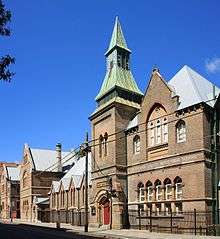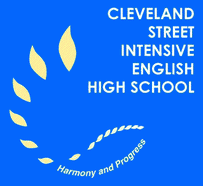Cleveland Street Intensive English High School
| Cleveland Street Intensive English High School | |
|---|---|
|
Harmony and Progress | |
| Address | |
|
Cnr Cleveland Street and Chalmers Street Surry Hills 2010, New South Wales Australia | |
| Coordinates | 33°53′S 151°13′E / 33.883°S 151.217°ECoordinates: 33°53′S 151°13′E / 33.883°S 151.217°E |
| Information | |
| Type | Public, Secondary, Co-educational, Day school |
| Religious affiliation(s) | None |
| Established | 1856 |
| Principal | Jennifer Pilon[1] |
| Staff | ~34[1] |
| Enrolment | ~225[1][2] |
| Campus | Urban |
| Colour(s) |
Blue and Yellow |
| Website | www.clevelandi-h.schools.nsw.edu.au |
Cleveland Street Intensive English High School (abbreviated to CSIEHS) is an ESL High School located in the inner-Sydney suburb of Surry Hills, New South Wales, Australia and operated by the New South Wales Department of Education and Communities. The school provides intensive English language, settlement, orientation and welfare programs to secondary aged, newly arrived permanent, temporary resident and international students.[3] Settlement support and partnership programs are provided for the school's culturally and linguistically diverse parent community. The school's student and parent community come from more than 30 language backgrounds other than English. Bilingual staff support student learning and parent programs. The school's motto "Harmony and Progress" reflects the proactively inclusive education and welfare programs designed to enhance student resilience and achievement.[2]
The school was founded in 1856, and was a general high school until 1977, when the school was moved to Alexandria and later renamed Alexandria Park Community School. It is one of the oldest public schools in Australia still operating on its site. The site on Cleveland Street was then reworked as an annex of the school for newly arrived immigrants into Australia, then into its current form as an intensive English-language high school in 2001.[4]
Students
Students attending the school can come from as many as 100 different countries, bringing with them a great diversity of languages, customs and beliefs. Students are all newly arrived, non-English speaking background students of high school age. They study at the school for between 15 and 50 weeks at the school[2] at which point most students transfer to other government high schools in order to complete their studies in the School Certificate or Higher School Certificate. Some students will choose to begin other courses of study at other institutions, such as Technical and Further Education TAFE, and some may go directly to the workplace.
The demographic mix of students is constantly shifting with national and international events, and geopolitics. The student body has been known to include migrants and/or refugees from China, Indonesia, South Korea, South America, Iraq, Sri Lanka, and Sudan.[5]
Staff
The staff consists of a principal, deputy principal, head teachers, classroom teachers, specialist migrant counsellors, and school assistant support staff (administration and bi-lingual). All teachers are trained in at least two methodologies with one being English as a Second Language (ESL). Many of the teachers are also bi-lingual.[4]
Curriculum
Departments
The curriculum at CSIEHS is based on the Intensive English Program Curriculum Framework, a document which describes an appropriate progression of English language acquisition and the language outcomes essential for students in an intensive English program. The English as a Second Language (ESL) program at this school is taught through the Key Learning Areas (KLAs) to assist students in preparation for their completion of the School Certificate and/or Higher School Certificate.[6] The program is taught through the following KLAs:
|
|
Sport
The PDHPE program at CSIEHS encompasses a range of sports that students participate in, including:[6]
History & Architecture
1851
The Australian gold rushes of 1850s increased the Australian population dramatically. In 1851, some land was reserved in the "Cleveland Paddocks" for a school to be established.[7]
1856
In 1856, "temporary" pre-fabricated galvanised iron buildings were imported from Liverpool, England and erected on the Cleveland Street site.[8] In its first year the school had an enrolment of 215 students. During this time Cleveland Street became one of the four "Model Schools", which included Fort Street, William Street (now closed [9]), and Paddington.[7][10]
1867

Following the 1866 Public Schools Act, the pre-fabricated galvanised iron buildings at Cleveland Street were demolished to be replaced by substantial buildings. These took 14 months to construct and have been described as Gothic Revival in architecture.[7]
1891
An additional wing was added to the school in what has been described as "Moderated Romanesque Style". It was at this time that the City Council granted the school its own access to and use of Prince Alfred Park as a playground.[7]
1909

Due to new ideas in education such as manual training and the teaching of science, the school received another building addition with specialist rooms called "shops".[7]
1913
The school became an Intermediate High School for boys and girls.[7]
1924
Another building was erected on the site, this time a three-storey building said to resemble an "egg-crate". It added a further eight new classrooms to the boys department.[7]
1956

Becomes an all boy's high school.[11]
1968
A "modern" building was constructed on the grounds, consisting of three levels and containing specialist rooms.[7]
1980
The high school moved to new grounds and new buildings in the adjacent suburb of Alexandria. The site at Cleveland Street became an annex to the new high school, but with a separate function, that of providing intensive English language tuition for newly arrived migrant students.[7]
2001
The site at Cleveland Street becomes a dedicated high school for intensive English tuition and is named "Cleveland Street Intensive English High School".[12]
Heritage listing
The school buildings that were opened in 1868 have been heritage listed since 1989.[8]
See also
References
- 1 2 3 "CSIEHS MySchool Profile (2013)". ACARA. Retrieved 22 February 2015.
- 1 2 3 "NSW Department of Education and Training". Department of Education and Communities. Retrieved 22 February 2015.
- ↑ "City of Sydney New Arrival Kit" (PDF). Sydney Multicultural Community Services (MCS). Retrieved 22 February 2015.
- 1 2 "CSIEHS Website-About Us". Retrieved 22 February 2015.
- ↑ "Lost in translation". National. The Sydney Morning Herald. 2004-11-20. Retrieved 22 February 2015.
- 1 2 "CSIEHS Website-Curriculum". Retrieved 23 February 2015.
- 1 2 3 4 5 6 7 8 9 "CSIEHS Website-History". Retrieved 22 February 2015.
- 1 2 "NSW Heritage Listing". Retrieved 22 February 2015.
- ↑ "William Street Public School". State Records NSW.
- ↑ "Paddington Public School". Department of Education and Communities.
- ↑ "Cleveland Street High School". City of Sydney-Barani.
- ↑ "CSIEHS Website-History-Memorabilia". Retrieved 22 February 2015.
External links
- CSIEHS website
- Department of Education and Communities:Cleveland Street Intensive English High School
